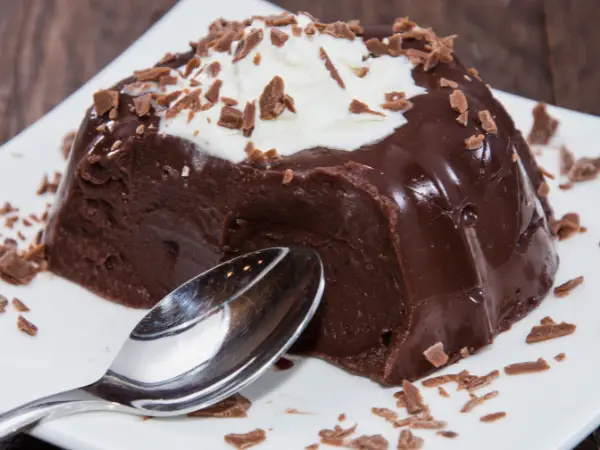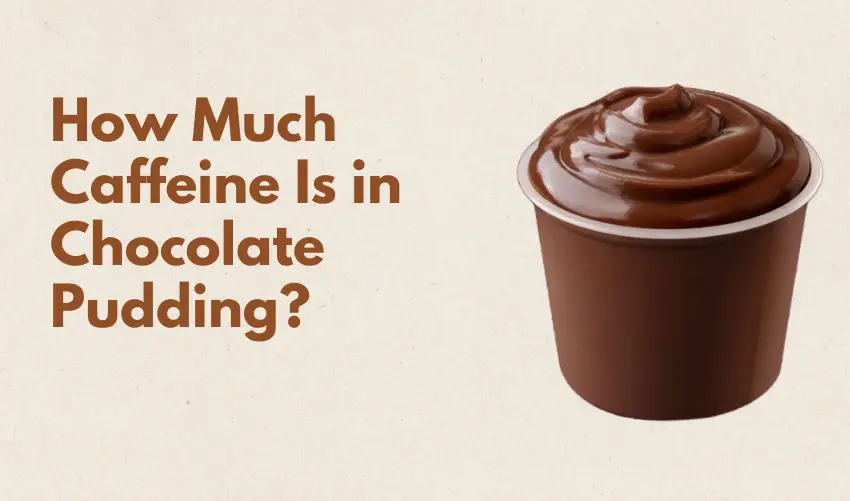Have you ever wondered how much caffeine is hiding in chocolate pudding? You might be surprised to learn that even a seemingly innocent dessert can pack a caffeine.
This guide we’ll break down the caffeine content in chocolate pudding, helping you understand what you’re really eating.
The Basics: Where Does Caffeine In Pudding Come From?
Understanding the basics of where caffeine in pudding comes from can help you enjoy your treat without surprises. This section will explore how much caffeine is in chocolate pudding and how it is affected by the ingredients used.
The Chocolate Connection: Cocoa’s Natural Caffeine
Caffeine is naturally present in cocoa beans. The amount of caffeine in chocolate pudding depends on the cocoa used. Here are some important points to consider:
- The darker the chocolate, generally the higher the cocoa content and caffeine.
- Pudding usually contains cocoa powder or chocolate.
- The amount of chocolate or cocoa used directly impacts caffeine levels.
- Added ingredients like milk or sugar dilute the caffeine concentration.
To give you a better idea of caffeine levels, here is a simple table comparing different types of chocolate:
| Type of Chocolate | Caffeine per 1 oz |
|---|---|
| Dark Chocolate (70-85% cocoa) | 25-40 mg |
| Milk Chocolate | 5-10 mg |
| White Chocolate | 0 mg |
From this table, you can see that dark chocolate has the most caffeine, while white chocolate has none. This is important to remember when enjoying chocolate pudding.
Processing Matters: How Pudding Is Made
The way pudding is made also affects its caffeine content. Many recipes call for cocoa powder or chocolate as a key ingredient. The specific type of cocoa used can greatly change the caffeine levels. For example:
- Homemade pudding often uses cocoa powder, which has varying levels of caffeine.
- Store-bought pudding may contain different chocolate blends.
- Some brands add extra ingredients that can change the caffeine concentration.
By understanding how pudding is made and the ingredients involved, you can better estimate the caffeine content in your chocolate pudding. Enjoy it wisely!

Understanding Caffeine Levels: A Closer Look
Understanding caffeine levels in food helps us make better choices. Chocolate pudding is generally very low in caffeine. Let’s take a closer look.
Typical Caffeine Content In Chocolate Pudding
The caffeine content in chocolate pudding is generally very low. Most servings contain less than 5-10 mg of caffeine. This amount is minimal compared to other common sources of caffeine. Here are some key points about caffeine in chocolate pudding:
- Low Caffeine Level: Often less than 5-10 mg per serving.
- Chocolate Type Matters: Caffeine levels can vary based on brand, serving size, and chocolate type.
- Milk vs. Dark Chocolate: Milk chocolate pudding usually has less caffeine than dark chocolate.
To understand how chocolate pudding compares to other foods, here’s a table of typical caffeine levels:
| Food Item | Caffeine Content (mg) |
|---|---|
| Chocolate Pudding | 5-10 |
| Milk Chocolate Bar (1.5 oz) | Approx 10-15 |
| Dark Chocolate Bar (1.5 oz) | Approx 20-30 |
As shown, chocolate pudding contains significantly less caffeine than coffee and tea.
Comparing Pudding To Other Chocolate Treats
When comparing chocolate pudding to other chocolate treats, the differences in caffeine content are clear. For example, milk chocolate bars contain more caffeine than pudding. Here are some comparisons:
- Chocolate Pudding: 5-10 mg of caffeine.
- Milk Chocolate Bars: Approx 10-15 mg of caffeine.
- Dark Chocolate Bars: Approx 20-30 mg of caffeine.
- Hot Cocoa: Usually has similar or slightly higher levels than pudding.
This information shows that if you want a low-caffeine dessert, chocolate pudding is a smart choice. It satisfies your sweet tooth without a caffeine overload.
Who Should Be Aware? Considering Caffeine Sensitivity
Who should pay attention to caffeine levels in chocolate pudding? Caffeine sensitivity varies among individuals. Understanding this can help people make better choices.
Impacts On Sensitive Individuals
Some people feel its effects even with small amounts. Chocolate pudding contains caffeine, which may impact these individuals. Here are some key points to consider:
- Even low doses can affect highly caffeine-sensitive people. They might experience jitters or anxiety.
- May cause mild jitters. Some people report feeling restless after eating chocolate pudding.
- Anxiety or sleep disturbances can arise. Sensitive individuals may struggle to relax after consuming caffeine.
- Children and pregnant individuals might be more susceptible. Their bodies process caffeine differently.
Understanding caffeine levels helps sensitive individuals manage their intake. They should enjoy chocolate pudding with caution.

Ideal For
This dessert is often enjoyed by those who appreciate sweetness without too much caffeine. Here are some groups who may find chocolate pudding suitable:
- Individuals seeking a mild chocolatey treat before bed. The low caffeine content can make it a safer option.
- Anyone managing caffeine sensitivity or certain health conditions. They can indulge without overwhelming their system.
- People who enjoy dessert after meals. Chocolate pudding is creamy and satisfying.
Chocolate pudding can be a delightful choice. With moderate caffeine levels, it fits nicely in many diets. Enjoy it responsibly.
Beyond Pudding: Other Hidden Caffeine Sources
What other hidden sources of caffeine exist in our daily diets? Knowing these sources helps you manage your caffeine intake.
Common Unexpected Sources
Caffeine hides in many foods and drinks. You may not expect it in some items. Here are common unexpected sources of caffeine:
- Certain pain relievers: Some over-the-counter pain medications contain caffeine.
- Energy drinks: These drinks are high in caffeine and sugar.
- Sports supplements: Many energy-boosting supplements include caffeine.
- Decaffeinated coffee: Some brands still contain trace amounts of caffeine.
- Chocolate-flavored items: Look out for chocolate syrup, ice cream, and baked goods.
Always check ingredient lists for cocoa. Cocoa products can contain caffeine. Chocolate liquor or caffeine may appear on labels. Be cautious with baked goods, candies, and desserts.
Reading Labels: Your Best Defense
Reading labels is crucial for managing caffeine intake. Many products do not list caffeine content. Nutrition labels may not always specify caffeine levels. This can lead to unintentional overconsumption.
Look for certain terms on labels:
- Cocoa: Indicates a source of caffeine.
- Chocolate liquor: A concentrated form of chocolate that contains caffeine.
- Natural flavors: These may derive from cocoa and contain caffeine.
Always check ingredient lists. Some products labeled as “decaffeinated” still contain small amounts of caffeine. This is important for those sensitive to caffeine. Being aware helps you make informed choices.
